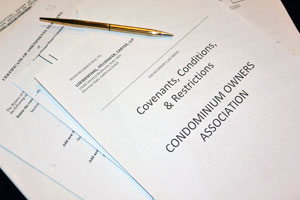LHC Newsletter Vol. 4, No. 4
“Understanding FHA Rules – Easier said than done”
By: David A. Loewenthal, Esq.
In the current economic climate, many associations struggle with budgets, delinquent accounts, foreclosures, and many other related issues. This said, indications are that new and some first time buyers are returning to the market. In better times, Federal Housing Authority (FHA) loan guarantees were key support elements to these and other buyer groups. However, FHA rules regarding qualified C.I.D.’s have changed greatly over the past year or two. This newsletter will summarize and provide informational links which we have obtained from the FHA on that agency’s rules as they impact condominiums and other HOA/CID type properties.
SUMMARY: FHA Requirements for Condominium Projects
As of November of 2009 (Per the FHA’s “Mortgagee Letter 2009-46 B – Link provided below) FHA “Project Eligibility Requirements” for their approval are generally summarized as follows.
- Minimum No. of Units: 2 or more
- Insurance Coverage: Hazard and liability and when applicable, flood and fidelity insurance.
- Commercial Space: No more than 25% of the property’s total floor area. The commercial portion of the project must be of a nature “homogenous with residential use.”
- Investor Ownership: No more than 10% of the units may be owned by one investor, including developer/builders that rent vacant or unsold units. All units, common elements, and facilities must be 100% complete.
- Delinquent HOA Dues: No more than 15% of the units in the project can be in arrears (more than 30 days).
- Pre-Sales: At least 50% of the total units must be sold prior to a FHA endorsement on any unit.
- Owner Occupancy Ratios: At least 50% of the units of a project must be owner occupied or sold to owners who intend to occupy the units.
- Legal Phasing: Legal phasing is permitted for condominium processing e.g.: multi-floor buildings in which units are sold by floor or in groups by floor a development which involved multiple buildings which are sold building by building.
- FHA Concentration: FHA will display the concentration information for each approved condominium development on the approved condominium listing. Projects of 3 or fewer – no more than one unit can be encumbered with FHA insurance; Projects of 4 or more units – no more than 30% so encumbered.
- Budget Review: Mortgagees must review the HOA budget to determine that the budget is adequate and: Includes allocations/line items ensuring sufficient funds to maintain and preserve all amenities and features unique to the association; Provides for the funding of replacement reserves to at least 10% of the budget; Provides adequate funding for insurance coverage and deductibles.
Link to entire text of HUD/FHA Mortgagee Letter 2009-46-B “Condominium Approval Process for Single Family Housing”:
http://www.hud.gov/offices/adm/hudclips/letters/mortgagee/fi les/09-46bml.pdf
Determining what this means to your association:
If a buyer requires FHA in order to buy a unit in an association, she or he will need to go through some fairly rigorous research and study to determine if each property they study meets FHA’s criteria. Thus, it would be a good idea for boards and property managers to have all pertinent information readily available. However, as we all know, some of these criteria, particularly the HOA dues/assessment delinquency requirement of 15% or less is a problematic one for a large number, if not the majority, of associations in our region. Collection issues* have been and most probably will continue to be critical to most of the associations whom we serve and advise. Market data indicate this is a general trend as well.
*See LHC Newsletter Vol. 4, No. 1 – The Collection End Game: https://lhclawyers.net/newsletter/LHCNwsltrVol4No1.pdf )
What can you do to ensure your association is FHA “approvable”
Rather than throw in the towel, association boards can work to enhance the salability of units within their associations by not only continuing and extending their efforts to reduce delinquency rates, but also by ensuring that all reserve studies are up to date and compliant. Review and discuss insurance coverage so as to ensure it meets FHA criteria. In most cases, it should already do so. Determine if your association already has reached the maximum level of FHA coverage among existing homeowners. While FHA approval viability is not a determinant factor for the ongoing salability of units within an association; it is a factor. Particularly now given the profiles of potential buyers who are entering or re-entering this real estate market.
Contact local FHA representatives to get their assistance in determining if your association meets the criteria and, if not, determine what changes might need to be made. Links to FHA contact and other information are provided at the end of the newsletter. In conducting research for this newsletter, we have found that local representatives were relatively accessible and helpful. Though often, they refer inquiries to their online “Resource” site: FHA Connection (https://entp.hud.gov/clas/index.cfm ).
Additionally, associations can use external resources to assist in obtaining FHA approval for a fee (e.g.: http://www.getfhaapproval.com/contact.html ).
Conclusion:
Adjusting to these economic times is a challenge for all of us. New and changed conditions require that we all think about and manage in different ways. Staying informed about the general marketplace, about specific alternatives and opportunities that arise and remaining vigilant about the overall health of an association remain key objectives. As always, Loewenthal, Hillshafer & Carter, LLP will keep you up to date as to changes affecting our industry.
FHA Contact and Informational Links:
Main California HUD/FHA Contact Page:
http://www.hud.gov/local/index.cfm?state=ca&topic=offices
FHA Condominium Mortgage Insurance Info Page:
http://www.hud.gov/offices/hsg/sfh/condo/index.cfm
FHA Connection (resource center):
https://entp.hud.gov/clas/index.cfm
FHA Temporary Guidance for Condominium Policy 2009-46 A:
http://www.hud.gov/offices/adm/hudclips/letters/mortgagee/files/09-46aml.pdf
FHA Mortgagee Letter 2009-46-B “Condominium Approval Process for Single Family Housing”:
http://www.hud.gov/offices/adm/hudclips/letters/mortgagee/fi les/09-46bml.pdf
FHA Condominium Processing Q&A’s (targeted primarily at developers and builders and undated):
http://www.hud.gov/offices/hsg/sfh/condo/faqs_condo.pdf
©2010 by Loewenthal, Hillshafer & Carter, LLP. All rights reserved. Permission is granted to reproduce or transmit in any form any part of this newsletter as long as proper attribution to Loewenthal, Hillshafer & Carter, LLP is given. Due to the rapidly changing nature of the law, information contained in this publication may become outdated. As a result, lawyers and all others using this material must research original sources of authority.


